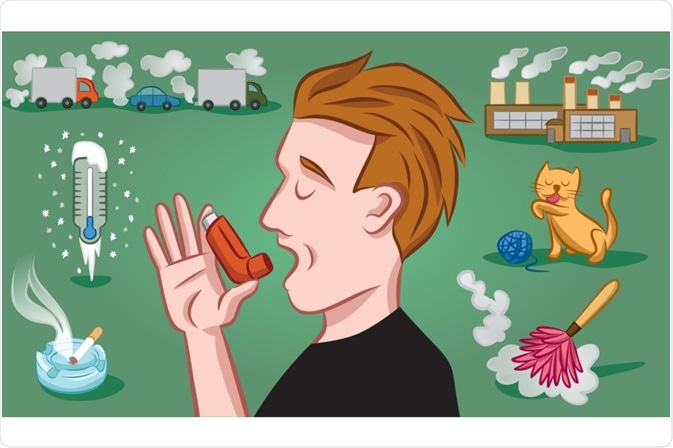Asthma and allergies are both very common health conditions that affect approximately 10% and 15% of the population in the United States, respectively. Additionally, it is estimated that 70% of individuals with asthma also suffer from allergies, suggesting that there may be a link in the pathology of the two conditions.
Allergic asthma is a type of asthma that is provoked by exposure to certain allergens, such as pollen, dust, mold, and animals. There are several similarities in how both asthma and allergies should be treated.

Image Credit: Daren Woodward / Shutterstock.com
Genetic relationship
There appears to be a genetic relationship between allergies and the development of asthma, as familial susceptibility is evident. If one or both parents suffer from allergies, there is an increased risk that any of their children will also suffer from allergies. Stemming from this, individuals with allergies are more likely to develop asthma as compared to the general population.
For this reason, it is worthwhile to be aware of the family history of both allergies and asthma. This information will help in the diagnosis and management of both of these conditions.
What is allergic asthma?
Allergic asthma is a type of asthma that involves asthma symptoms that are induced by the presence of allergens, commonly referred to as triggers.
These allergens cause the immune system to respond by releasing immunoglobulin E (IgE) to the area, which leads to inflammation and swelling in the lungs. The airways can become narrower as a result and make it difficult for the individual to breathe normally.
Allergic asthma triggers
There are several triggers that are known to provoke an allergic reaction and worsen the symptoms of asthma in affected individuals. These include:
- Pollen: These are the airborne particles that come from trees, grasses, and weeds outside.
- Dust mites: The feces and body parts of the tiny dust mites found in fabric-based items such as mattresses, pillows, carpets, clothes, and stuffed toys.
- Mold: The airborne spores produced by molds found inside or outside where moisture is present.
- Pets: The urine, feces, saliva, hair, or dander of pets.
- Cockroaches: The feces, saliva, and/or body parts of the insects.
It is important that people who suffer from allergic asthma are aware of these triggers, particularly any which they have noted have an effect on their symptoms.
Allergies and Asthma: Symptoms, Causes, and Treatment Options
Similarities in management
There are several management techniques that can offer a benefit for individuals suffering from asthma, allergies, or both of these conditions. In particular, it is important to identify and limit exposure to triggers that are linked to the worsening of symptoms for individuals with allergic asthma.
There are also some similarities in the symptomatic treatment, as both conditions are marked by inflammation that needs to be controlled to relieve symptoms. For example, montelukast is a medication that is used to control the immune system response during an allergic reaction. This can be taken daily to reduce the occurrence of symptoms of both allergies and asthma.
Immunotherapy is an alternative option to reduce the inflammation associated with allergic asthma and the individual's response to triggers. This is a more complex process, involving regular injections over an extended time period with a small concentration of allergens to increase tolerance and reduce symptoms.
References
Further Reading
Last Updated: Dec 21, 2022